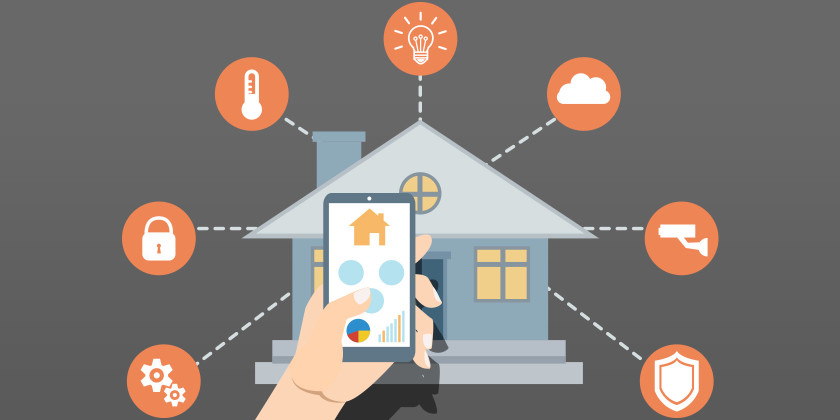Smart home checklist
Did you know there are a few different levels of ‘smart home’? For example, the term smart can be anything from a thermostat that you control remotely, to a fully connected home that is completely wired and designed to offer a heightened level of comfort and efficiency.
Navigating the world of ‘smart technology’ can be overwhelming, especially if you’re a technophobe but don’t worry, it’s not that difficult to bring your home in to the 21st century so it starts working for you, instead of against you!
Helping you to embark on your very own ‘smart home’ journey, Ivory Egg outline the do's and don’ts of smart home design and creation - regardless of the type of system you’re looking for:
Do consider what you are expecting the system to be able to do.
If music is your thing, then a simple solution that enables multiple rooms to be playing the same music is probably the perfect solution for you. This can be achieved with a selection of network connected speakers, however, if the sound quality of your music is what interests you then a higher-end, single-room solution is recommended. Whether it is functionality or performance, there is a host of smart audio systems that will deliver.
Don’t forget the network.
Most routers supplied by internet providers will struggle to provide a consistent performance: especially when you have more than 20 devices connected. That may sound like a lot, but this can very quickly be achieved in a home where smart technology is installed.
Wireless coverage can also be an issue if you have the luxury of a large property. Relying on a mobile phone connection is fine when streaming content via YouTube, but to control and interface to products will require a home network: a group of devices, such as computers, game systems, printers, and mobile devices, that connect to the internet and each other.
There are various off-the-shelf solutions you can choose that will extend the Wifi capabilities throughout your home, but again, the router will still become an inevitable point of weakness. Enlist the expertise of a professional home tech installer, as they can advise you on the best approach. By doing so, you will ensure connectivity throughout the home that is able to cope with a typical family with high usage, along with the ability to include critical systems like lighting and heating.
Don’t confuse smart devices with smart systems. If you are looking to build a new home, or improving an existing one, installing a wired infrastructure will provide far greater long term flexibility and breadth of possibilities. Adding smart devices over the top of existing wiring is a great solution when you can’t rewire, but it can limit what you can achieve: particularly at a house wide level. That being said, if you engage a professional smart home installer they will be able to help you get the most from whichever system is being installed.
Don’t give up using a product after only a few times. Most smart home devices, particularly those based around voice interfaces, improve the more you use them and the more systems that you have connected. Checking the weather is certainly useful, but being able to dim the lights, shut the blinds and play your favourite album with one simple command is far more helpful. A lot of systems now have a degree of computer learning so the technology becomes tuned to your lifestyle and habits, the more you use them, the better they get.
Don’t get caught up with scaremongering around security and data protection. The majority of systems from well-known brands are inherently secure, and the manufacturers do everything possible to protect your data. Voice devices may always be listening, but they are not always recording. This feature only comes in to effect when a key word is said, at this point the voice application will make a secure connection to the cloud and process your command.
That being said, do change the default passwords.
Security is a two-way street, so make sure to do your part by using strong passwords on devices and changing them regularly. Also, make sure you don’t alter the settings in your router that opens your home to the outside world, if you are not sure, please seek expert advice.
Do consider smart home technology as an investment.
When approached the right way, technology can be used to not only make your life easier, but also make your home more comfortable, secure, efficient and healthier. This leads to a better and more enjoyable home which is the type of investment that over time, will really pay dividends for you, your lifestyle and your entire family.
There are countless places you can get more information on smart homes, so once you have done your research and have a good idea of what you can’t live without, then find a professional who will be able to ensure you get the best possible performance, regardless of the system you choose.
This article was written by Ivory Egg, specialists in KNX intelligent building technology and complementary solutions.
--CIAT
[edit] Related articles on Designing Buildings Wiki
Featured articles and news
RTPI leader to become new CIOB Chief Executive Officer
Dr Victoria Hills MRTPI, FICE to take over after Caroline Gumble’s departure.
Social and affordable housing, a long term plan for delivery
The “Delivering a Decade of Renewal for Social and Affordable Housing” strategy sets out future path.
A change to adoptive architecture
Effects of global weather warming on architectural detailing, material choice and human interaction.
The proposed publicly owned and backed subsidiary of Homes England, to facilitate new homes.
How big is the problem and what can we do to mitigate the effects?
Overheating guidance and tools for building designers
A number of cool guides to help with the heat.
The UK's Modern Industrial Strategy: A 10 year plan
Previous consultation criticism, current key elements and general support with some persisting reservations.
Building Safety Regulator reforms
New roles, new staff and a new fast track service pave the way for a single construction regulator.
Architectural Technologist CPDs and Communications
CIAT CPD… and how you can do it!
Cooling centres and cool spaces
Managing extreme heat in cities by directing the public to places for heat stress relief and water sources.
Winter gardens: A brief history and warm variations
Extending the season with glass in different forms and terms.
Restoring Great Yarmouth's Winter Gardens
Transforming one of the least sustainable constructions imaginable.
Construction Skills Mission Board launch sector drive
Newly formed government and industry collaboration set strategy for recruiting an additional 100,000 construction workers a year.
New Architects Code comes into effect in September 2025
ARB Architects Code of Conduct and Practice available with ongoing consultation regarding guidance.
Welsh Skills Body (Medr) launches ambitious plan
The new skills body brings together funding and regulation of tertiary education and research for the devolved nation.
Paul Gandy FCIOB announced as next CIOB President
Former Tilbury Douglas CEO takes helm.
UK Infrastructure: A 10 Year Strategy. In brief with reactions
With the National Infrastructure and Service Transformation Authority (NISTA).
























